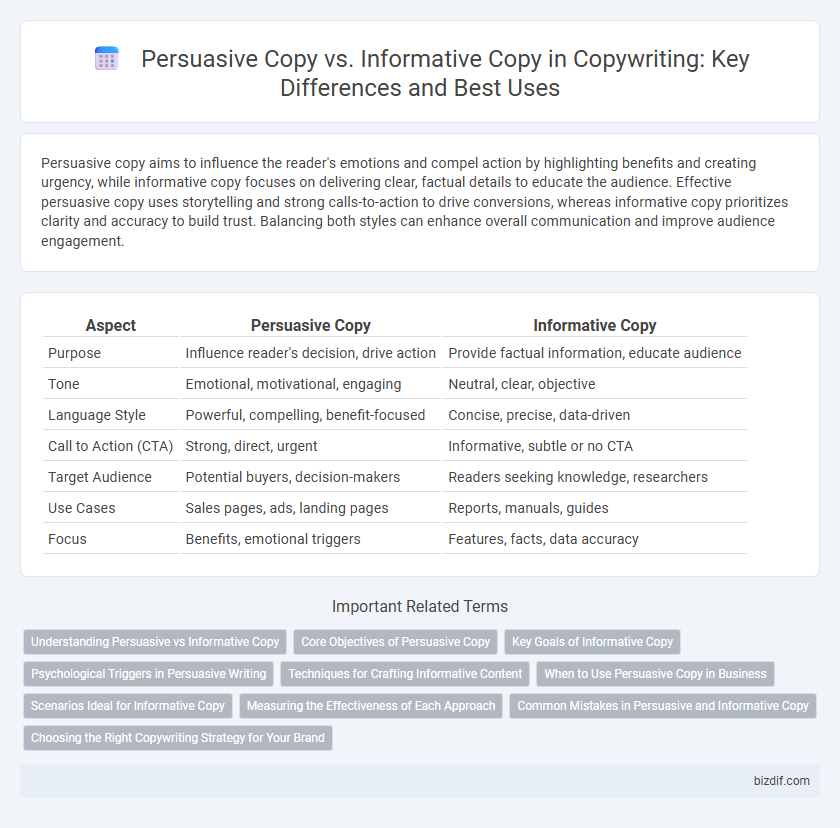Persuasive copy aims to influence the reader's emotions and compel action by highlighting benefits and creating urgency, while informative copy focuses on delivering clear, factual details to educate the audience. Effective persuasive copy uses storytelling and strong calls-to-action to drive conversions, whereas informative copy prioritizes clarity and accuracy to build trust. Balancing both styles can enhance overall communication and improve audience engagement.
Table of Comparison
| Aspect | Persuasive Copy | Informative Copy |
|---|---|---|
| Purpose | Influence reader's decision, drive action | Provide factual information, educate audience |
| Tone | Emotional, motivational, engaging | Neutral, clear, objective |
| Language Style | Powerful, compelling, benefit-focused | Concise, precise, data-driven |
| Call to Action (CTA) | Strong, direct, urgent | Informative, subtle or no CTA |
| Target Audience | Potential buyers, decision-makers | Readers seeking knowledge, researchers |
| Use Cases | Sales pages, ads, landing pages | Reports, manuals, guides |
| Focus | Benefits, emotional triggers | Features, facts, data accuracy |
Understanding Persuasive vs Informative Copy
Persuasive copy aims to influence the audience's emotions and prompt immediate action through compelling language and strong calls to action, while informative copy focuses on delivering clear, factual information to educate the reader about a product or service. Effective persuasive copy leverages psychological triggers such as scarcity, social proof, and urgency, whereas informative copy prioritizes clarity, depth, and accuracy to build trust. Understanding the distinct goals and techniques of each copy type enables marketers to tailor content strategies that both engage and inform their target audiences effectively.
Core Objectives of Persuasive Copy
Persuasive copy aims to evoke emotions and drive action by focusing on benefits, addressing pain points, and creating a sense of urgency. Unlike informative copy, which centers on delivering facts and features, persuasive copy seeks to influence decisions and motivate purchases. Its core objectives include building trust, highlighting unique value propositions, and compelling the audience toward conversion.
Key Goals of Informative Copy
Informative copy prioritizes delivering clear, factual information to educate the audience and enhance their understanding of a product or service. It aims to build trust by presenting objective data, features, and benefits without overtly pushing for a sale. The key goals include increasing awareness, providing value through knowledge, and supporting informed decision-making.
Psychological Triggers in Persuasive Writing
Persuasive copy leverages psychological triggers such as social proof, scarcity, and urgency to motivate immediate action, deeply engaging readers' emotions and cognitive biases. Informative copy prioritizes clarity and factual accuracy, providing essential details to educate and build trust without necessarily driving impulse decisions. Understanding these psychological mechanisms enhances persuasive writing by creating compelling, action-oriented messages that resonate on a subconscious level.
Techniques for Crafting Informative Content
Techniques for crafting informative content include thorough research to ensure accuracy and credibility, use of clear and concise language to enhance understanding, and structured formatting with headings and bullet points for easy navigation. Incorporating relevant data, statistics, and factual evidence helps establish trust and authority, while avoiding jargon makes the content accessible to a broader audience. Effective informative copy balances detail with readability, aiming to educate the reader without overwhelming them.
When to Use Persuasive Copy in Business
Persuasive copy is essential in business when the goal is to drive action, such as boosting sales, increasing sign-ups, or encouraging customer engagement. This type of copy uses emotional triggers, clear calls-to-action, and benefits-focused language to motivate potential buyers. Employ persuasive copy in marketing campaigns, product launches, and promotional offers to maximize conversion rates and generate measurable results.
Scenarios Ideal for Informative Copy
Informative copy excels in educational content, product descriptions, and technical documentation where clarity and detailed explanations are paramount. Industries like healthcare, technology, and finance benefit from informative copy to build trust and provide essential knowledge to consumers. This approach enhances user understanding and supports decision-making processes without the pressure of immediate conversion.
Measuring the Effectiveness of Each Approach
Measuring the effectiveness of persuasive copy hinges on tracking conversion rates, click-through rates, and emotional engagement metrics, which reveal how well the content drives consumer actions and influences decision-making. Informative copy effectiveness is primarily gauged through metrics like time on page, bounce rate, and knowledge retention, indicating how successfully the content educates and informs the audience. Utilizing A/B testing and analytics tools enables marketers to compare the impact of each approach on specific campaign goals and optimize content strategies accordingly.
Common Mistakes in Persuasive and Informative Copy
Common mistakes in persuasive copy include overusing emotional appeals without substantiating claims, leading to reduced credibility and audience skepticism. Informative copy often falters by being overly dense with technical jargon, causing reader disengagement and confusion. Both types suffer when failing to clearly address the target audience's needs, diminishing overall effectiveness and conversion rates.
Choosing the Right Copywriting Strategy for Your Brand
Persuasive copy aims to drive action by appealing to emotions and emphasizing benefits, making it ideal for sales-focused campaigns. Informative copy prioritizes clarity and facts, building trust and educating the audience, which suits brands seeking authority and long-term engagement. Selecting the right copywriting strategy depends on your brand's goals, target audience, and the desired customer journey stage.
Persuasive Copy vs Informative Copy Infographic

 bizdif.com
bizdif.com